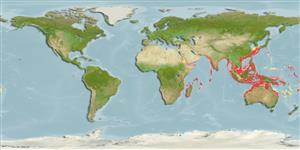Common names from other countries
>
Eupercaria/misc (Various families in series Eupercaria) >
Sciaenidae (Drums or croakers)
Etymology: Atrobucca: Latin, atro = black + Latin, bucca = mouth (Ref. 45335).
More on authors: Jordan & Thompson.
Environment: milieu / climate zone / depth range / distribution range
Ekologi
laut dasar (demersal); kisaran kedalaman 45 - 200 m (Ref. 9772), usually ? - 120 m (Ref. 7483). Deep-water; 38°N - 31°S, 30°E - 137°E
Indo-West Pacific: Mozambique and Natal, South Africa (Ref. 12484), India (Ref. 4373); China, Japan, Philippines, Indonesia, and off northern Australia.
Length at first maturity / Size / Weight / umur
Maturity: Lm 14.5 range ? - ? cm
Max length : 45.0 cm SL jantan/; (Ref. 9772); common length : 25.0 cm SL jantan/; (Ref. 9772)
Duri punggung (Keseluruhan (total)) : 10 - 11; duri punggung lunak (Keseluruhan (total)) : 27 - 33; Duri dubur: 2; Sirip dubur lunak: 7. A small, moderately-deep-bodied species. Swim bladder carrot-shaped, with 24 to 30 pairs of branched appendages, each with a dorsal and a ventral limb, regularly arranged so that the twiglets of the dorsal limb point backwards, and those near the tip of the ventral limb point forwards. The lateral line scales reaching the tip of the caudal fin. The linings of the mouth, gill chamber and body cavity black.
Found in coastal waters down to a depth of 200 m or deeper (Ref. 9772), on seaweed beds and gravel (Ref. 11230). Important food fish.
Life cycle and mating behavior
Maturities | Reproduksi, perkembang biakan | Spawnings | Egg(s) | Fecundities | Larva
Sasaki, K. and P.J. Kailola, 1988. Three new Indo-Australian species of the sciaenid genus Atrobucca, with a reevaluation of generic limit. Jap. J. Ichthyol. 35(3):261-277. (Ref. 7483)
Status IUCN Red List (Ref. 130435)
CITES (Ref. 128078)
Not Evaluated
ancaman kepada manusia
Harmless
penggunaan manusia
Perikanan: komersial
Alat, peralatan
laporan khas
muat turun XML
Sumber internet
Estimates based on models
Preferred temperature (Ref.
115969): 18.2 - 27.9, mean 24.5 (based on 609 cells).
Phylogenetic diversity index (Ref.
82804): PD
50 = 0.5010 [Uniqueness, from 0.5 = low to 2.0 = high].
Bayesian length-weight: a=0.00832 (0.00493 - 0.01404), b=3.04 (2.90 - 3.18), in cm Total Length, based on LWR estimates for this species & (Sub)family-body (Ref.
93245).
Trophic level (Ref.
69278): 4.0 ±0.69 se; based on food items.
Daya lenting (Ref.
120179): sedang, Waktu penggandaan populasi minimum 1.4 - 4.4 tahun (K=0.15-0.3).
Fishing Vulnerability (Ref.
59153): High vulnerability (56 of 100).
Climate Vulnerability (Ref.
125649): High to very high vulnerability (69 of 100).
